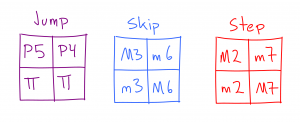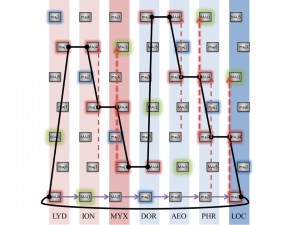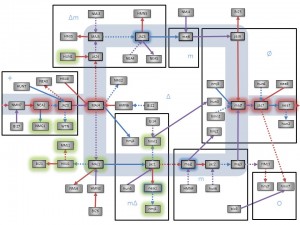Key/Chord/Mode (KCM)
is an advanced music theory
based on chromatically-inspired heptatonic scales
KCM is the next jump/skip/step in 12-TET music theory!

As fire refining burns away impurities in iron, KCM makes music theory cleaner, shinier, and singular of purpose by using mathematical structures, not history, as a guide in what burns away and what remains.
KCM uses category theory, psychoaccoustics, and gestalt principles to create diagrams that summarize and visualize western music theory.
Here you will find a consistent framework that will solidify your existing knowledge of music theory and expand the expressive content of your musical compositions and performances.
Diagram 1: The major key/chord/mode is universal.
This is a statement that the Major Scale, or equivalently the Ionian Mode, establishes universal harmonic and melodic patterns that can be followed or broken in music. In effect we treat the Major Scale as the template upon which all other musical structures will be based upon.
A primary example of the universality of the major scale is MAN, the Major Accidental Network pictured above. This diagram generalizes movements between modes and naturally leads to the constructions of Accidental Loops and Wheels. Conventional notes can always be recovered from Accidental Space though a mapping procedure involving Characteristic Intervals.
Diagram 2: Tritone’s determines key center, chord expectations, and mode structure.
After the Major Scale, the Tritone is the next most important concept in KCM. This is because the Tritone is seen as the best guidepost for traveling though any musical space. It stands out, both visually as black lines in the diagram above and auditorially though the psychoaccoustic discomfort it produces.
Looking at a Key-Chord diagram above we see a clear Tritone pattern that leads to the Tonic, Dominant, and Subdominant designations within a scale. This leads to the Harmonic concepts of “being pulled to the tonic” or “the dominant resolves to the tonic”. How composers have traditionally avoided the Tritone melodically is discussed in Diagram 4.
Diagram 3: Mode’s position in accidental space determines its chord quality.
While the previous ideas on the Major Scale and Tritones are firmly grounded in centuries of western tradition, Accidental Space is a concept developed for and unique to KCM. It builds on the need for a system that generalizes the universal structure of the Characteristic Intervals such that it provides a note-independent way to view any musical space.
Next to the Major Accidental Network, the most important visual in Accidental Space is The Big Loop shown above, a diagram which interconnects 11 scales and clearly shows how their 60+ modes form Quality Clusters.
Diagram 4: Minimizing tritones and beats in a key/chord/mode leads to maximal functional harmony.
Psychoaccoustics clearly shows that what is traditionally knows as “dissonance” can be broken down into a psychoaccoustic discomfort caused by the Tritone and beats. And thus it follows that if these effects are minimized in a composition then we maximize what is considered functional harmony or counterpoint.
KCM postulates that the Tritone and beats are the two effects that we may wish to minimize.. not avoid and certainly not exclude! Simply minimize as too much Tritone risks losing or switching the key center. This concept is derived from an analysis of various composers works in western music including Bach shown above, Beethoven, Gershwin, and more.
Copyright note: all pictures used in this blog not copyrighted by futur-e-scape are used by fair use provision of USA copyright law.





